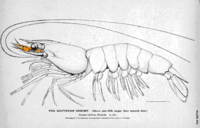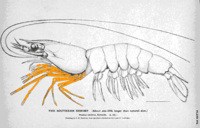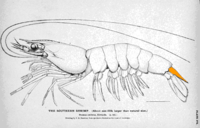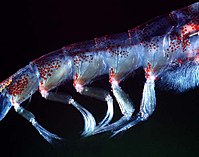
Dendrobranchiata is a suborder of decapods, commonly known as prawns. There are 540 extant species in seven families, and a fossil record extending back to the Devonian. They differ from related animals, such as Caridea and Stenopodidea, by the branching form of the gills and by the fact that they do not brood their eggs, but release them directly into the water. They may reach a length of over 330 millimetres (13 in) and a mass of 450 grams (1.0 lb), and are widely fished and farmed for human consumption.

Malacostraca is the second largest of the six classes of pancrustaceans behind insects, containing about 40,000 living species, divided among 16 orders. Its members, the malacostracans, display a great diversity of body forms and include crabs, lobsters, spiny lobsters, crayfish, shrimp, krill, prawns, woodlice, amphipods, mantis shrimp, tongue-eating lice and many other less familiar animals. They are abundant in all marine environments and have colonised freshwater and terrestrial habitats. They are segmented animals, united by a common body plan comprising 20 body segments, and divided into a head, thorax, and abdomen.

The Decapoda or decapods are an order of crustaceans within the class Malacostraca, and includes crabs, lobsters, crayfish, shrimp, and prawns. Most decapods are scavengers. The order is estimated to contain nearly 15,000 extant species in around 2,700 genera, with around 3,300 fossil species. Nearly half of these species are crabs, with the shrimp and Anomura including hermit crabs, king crabs, porcelain crabs, squat lobsters making up the bulk of the remainder. The earliest fossils of the group date to the Devonian.

Squat lobsters are dorsoventrally flattened crustaceans with long tails held curled beneath the cephalothorax. They are found in the two superfamilies Galatheoidea and Chirostyloidea, which form part of the decapod infraorder Anomura, alongside groups including the hermit crabs and mole crabs. They are distributed worldwide in the oceans, and occur from near the surface to deep sea hydrothermal vents, with one species occupying caves above sea level. More than 900 species have been described, in around 60 genera. Some species form dense aggregations, either on the sea floor or in the water column, and a small number are commercially fished.

An appendage is an external body part or natural prolongation that protrudes from an organism's body such as an arm or a leg. Protrusions from single-celled bacteria and archaea are known as cell-surface appendages or surface appendages. In many kinds of eukaryotic cell the protrusions are known as membrane protrusions or cell appendages.

Cumacea is an order of small marine crustaceans of the superorder Peracarida, occasionally called hooded shrimp or comma shrimp. Their unique appearance and uniform body plan makes them easy to distinguish from other crustaceans. They live in soft-bottoms such as mud and sand, mostly in the marine environment. There are more than 1,500 species of cumaceans formally described. The species diversity of Cumacea increases with depth.

Triops longicaudatus is a freshwater crustacean of the order Notostraca, resembling a miniature horseshoe crab. It is characterized by an elongated, segmented body, a flattened shield-like brownish carapace covering two thirds of the thorax, and two long filaments on the abdomen. The genus name Triops comes from Greek ὤψ or ṓps, meaning "eye" prefixed with Latin tri-, "three", in reference to its three eyes. Longicaudatus is a Latin neologism combining longus ("long") and caudatus ("tailed"), referring to its long tail structures. Triops longicaudatus is found in fresh water ponds and pools, often in places where few higher forms of life can exist.

Angustidontus is a genus of predatory pelagic crustaceans from the Late Devonian and Early Carboniferous periods, classified as part of the subclass Eumalacostraca. Fossils of the genus have been recovered in relative abundance from Canada, Germany, the Czech Republic, Poland, Belarus, Ukraine and large parts of the United States, including Oklahoma, Ohio, Indiana, Kentucky, Montana, Utah, Nevada.

Dromia personata, also known as the sponge crab or sleepy crab, is a species of crab found in the North Sea, the Mediterranean Sea, and connecting parts of the northeastern Atlantic Ocean. Like most other epibenthic crustaceans, the biomass of this species is especially dense in the Mediterranean continental shelf. It mainly resides from the lower shore to a depth of 50 meters (164 ft), often in caves. Occasionally, they are found living in depths as low as 110 meters (360 ft). They serve as prey for octopus, starfish, and other fish. Their last two pairs of legs are positioned dorsally, and are used to hold a sponge in place as camouflage.

Crustaceans may pass through a number of larval and immature stages between hatching from their eggs and reaching their adult form. Each of the stages is separated by a moult, in which the hard exoskeleton is shed to allow the animal to grow. The larvae of crustaceans often bear little resemblance to the adult, and there are still cases where it is not known what larvae will grow into what adults. This is especially true of crustaceans which live as benthic adults, more-so than where the larvae are planktonic, and thereby easily caught.
This glossary describes the terms used in formal descriptions of spiders; where applicable these terms are used in describing other arachnids.

Neoglyphea inopinata is a species of glypheoid lobster, a group thought long extinct before Neoglyphea was discovered. It is a lobster-like animal, up to around 15 centimetres (5.9 in) in length, although without claws. It is only known from 17 specimens, caught at two sites – one at the entrance to Manila Bay in the Philippines, and one in the Timor Sea, north of Australia. Due to the small number of specimens available, little is known about the species, but it appears to live up to five years, with a short larval phase. A second species, previously included in Neoglyphea, is now placed in a separate genus, Laurentaeglyphea.

Oregonia gracilis, commonly known as the graceful decorator crab, is a species of crab belonging to the family Oregoniidae. Like other decorator crabs it habitually attaches other organisms to its back. The sessile organisms are attached to hooked setae that act as a sort of velcro attachment. This decoration provides visual and chemical camouflage thus reducing predation risk. Pacific halibut are a major predator of O. gracilis. Other predators include octopus and sea otters. The main food source of O. gracilis is floating kelp and algae that they capture utilizing a waiting strategy in order to maintain cryptosis.

A shrimp is a crustacean with an elongated body and a primarily swimming mode of locomotion – typically belonging to the Caridea or Dendrobranchiata of the order Decapoda, although some crustaceans outside of this order are also referred to as "shrimp".

Oregonia bifurca, commonly known as the split-nose crab or the split-nose decorator crab, is a species of crabs belonging to the family Oregoniidae. It is a rare deep-water species that inhabits the tops of seamounts and guyots in the northeastern Pacific Ocean; from the Aleutian Islands, the Bering Sea, the Hawaiian–Emperor seamount chain, to the waters off British Columbia. It is closely related to the more common shallow-water species Oregonia gracilis, the graceful decorator crab.

Albunea carabus is a rare species of "sand crab" or "mole crab" in the family Albuneidae. It lives in shallow, turbulent waters in sandy areas of the tropical eastern Atlantic Ocean and the Mediterranean Sea.
Periclimenes pholeter, is a species of shrimp belonging to the family Palaemonidae. The species is closest to Periclimenes indicus, P. obscurus and P. toloensis, resembling these species in the presence of an epigastric tooth on the carapace, the shape of the abdomen, the spinulation of the carapace, and the unarmed fingers of the first chelipeds. P. pholeter most resembles P. indicus by the elongatecarpus and long fingers of the second pereiopods, differing in these features from P. toloensis, which has the fingers slightly less than half as long as the palm. In P. obscurus the fingers are shorter than the palm, but the carpus is about as long as the palm. From P. indicus, this species differs: by the greater size; by the much higher rostrum and the greater number of ventral rostral teeth; by the shorter eye; by the less slender antennular peduncle; by the more deeply cleft upper antennular flagellum; by the more robust scaphocerite; by the fingers of the first pereiopods ; by the more slender pereiopods, especially the fifth, which is much longer than the ischium.

Crustaceans are invertebrate animals that constitute one group of arthropods that are a part of the subphylum Crustacea, a large, diverse group of mainly aquatic arthropods including decapods, seed shrimp, branchiopods, fish lice, krill, remipedes, isopods, barnacles, copepods, opossum shrimps, amphipods and mantis shrimp. The crustacean group can be treated as a subphylum under the clade Mandibulata. It is now well accepted that the hexapods emerged deep in the Crustacean group, with the completed pan-group referred to as Pancrustacea. The three classes Cephalocarida, Branchiopoda and Remipedia are more closely related to the hexapods than they are to any of the other crustaceans.
Squilla empusa is a species of mantis shrimp found in coastal areas of the western Atlantic Ocean. It excavates and occupies a burrow in soft sediment from which it emerges, mainly at night, to feed on fish and invertebrate prey.
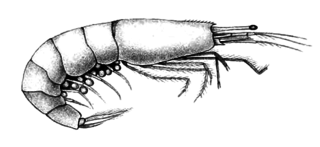
Ogyrides, also known as long eyed shrimps, is a genus of decapod crustaceans consisting of 13 species. It is the only genus in the monotypic family Ogyrididae.
